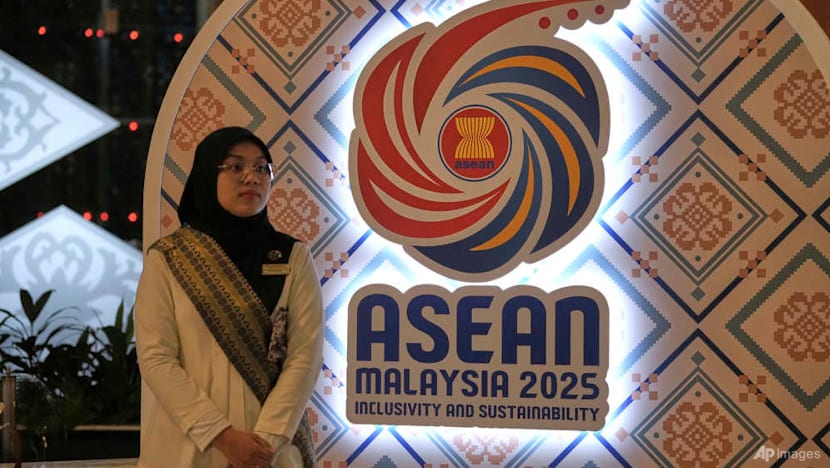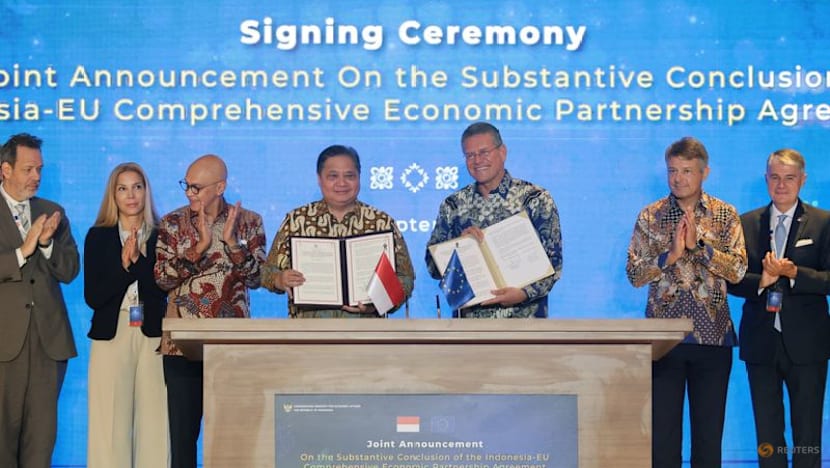Commentary: Southeast Asia is one of few economic bright spots from Europe’s point of view
Amid tariffs and great power competition, ASEAN has always sought to avoid being confined to a binary choice between the US and China. That’s where Europe should come in, says Chris Humphrey from the EU-ASEAN Business Council.

A hotel employee stands in front of the ASEAN logo waiting for delegates to arrive at a hotel in Kuala Lumpur, Malaysia, on Apr 9, 2025. (Photo: AP/Vincent Thian)

This audio is generated by an AI tool.
SINGAPORE: From Europe’s perspective, Southeast Asia is one of the few bright spots in today’s uncertain economy in a world unsettled by tariffs and geopolitical rifts.
In the EU-ASEAN Business Council’s recently published 11th EU-ASEAN Business Sentiment Survey, 73 per cent of respondents said the region has become more important to their global revenues over the past two years. For companies that are considering moving supply chains because of tariffs, 39 per cent said they are looking to the Association of Southeast Asian Nations (ASEAN) first, making it the top destination.
Though European companies are particularly bullish on expanding operations in Vietnam, Indonesia, Malaysia and Thailand, part of ASEAN’s attraction is in its diverse markets. This offers resilience through variety.
That resilience matters. From the ripple effects of the pandemic to the latest rounds of the United States' tariff hikes, recent years have served as a stark reminder of the fragility of global supply chains.
For European businesses, the question is no longer whether ASEAN matters, but how deeply they should commit.
The question then becomes whether Europe itself can keep pace – and whether Brussels will step up with the political ambition needed to match the business community’s appetite.
COMMON INTERESTS, MUTUAL APPEAL
ASEAN’s attraction is hardly surprising. With a combined population of more than 670 million and an economy projected to become the world’s fourth-largest by 2030, it possesses all the fundamentals investors seek: a young demographic, rising middle-class consumption, rapid urbanisation and a steady track record of economic reform.
The geopolitical backdrop has sharpened ASEAN’s value. On the one hand, the US has doubled down on tariff-driven disruption.
On the other hand, China is pressing ahead with an upgraded ASEAN-China Free Trade Agreement (ACFTA 3.0), due to be signed by leaders in October. But Beijing’s continued assertiveness in the South China Sea underlines just how geoeconomics and geopolitics are intricately intertwined in this part of the world.
In the crosshairs of great power competition, ASEAN’s priority has always been to maintain strategic balance and avoid being confined to a binary choice between Washington and Beijing. In the State of Southeast Asia Survey conducted by the ISEAS-Yusof Ishak Institute, the EU has been consistently the preferred hedge against uncertainties arising from US-China rivalry.
Europe’s appeal is also clear here, with its support for a multilateral rules-based trading order, continued support for ASEAN regional integration, reputation for consistency and reliability, and as a leader in sustainable economic development.
Crucially, greater EU engagement would not just benefit European businesses – it would also advance ASEAN’s own priorities.
These include driving forward the ASEAN Economic Community, fostering regional supply chain resilience, supporting the digital economy, and delivering on sustainability commitments. By showing up with capital, expertise and long-term commitment, Europe can position itself as a partner that empowers ASEAN’s growth story rather than merely tapping into it.
Yet, businesses think EU engagement is insufficient. Almost eight in 10 respondents of the business sentiment survey feel disadvantaged compared with competitors from Japan, Korea, China and Australia, all of which already enjoy ASEAN-wide Free Trade Agreements (FTAs).

WHY A REGION-TO-REGION FTA IS ESSENTIAL
To be fair, significant progress is being made on bilateral trade agreements. The EU-Indonesia FTA was announced as completed on Sep 23 after nearly a decade of negotiations, adding to the EU-Singapore and EU-Vietnam FTAs that are already in force.
Malaysia, Thailand and the Philippines have also resumed trade negotiations. The EU’s Commissioner for Trade and Economic Security said he expected to finalise FTAs with these countries by 2027, the year EU and ASEAN mark 50 years of diplomatic relations.
There is also innovation in the pipeline. The EU and Singapore signed a landmark Digital Trade Agreement earlier this year, which could serve as a template for a wider set of rules governing e-commerce, data flows and digital services across ASEAN.
But these efforts remain fragmented. With a patchwork of bilateral agreements rather than a bloc-to-bloc deal, Europe risks being seen as a second-tier partner – useful, but not indispensable.
The case for an EU-ASEAN FTA is overwhelming, especially once all of the bilateral FTAs are in place.
Such a deal would provide market-wide access, allowing European firms to scale more effectively across Southeast Asia and ASEAN companies to tap one of the world’s largest consumer markets. It would reduce supply chain friction by harmonising regulatory standards.
ASEAN’s strategic focus on developing the digital and green economies aligns perfectly with European strengths, which could unlock new areas of cooperation. Not only do European consumers place a premium on sustainability, but European companies increasingly see it as a source of competitive strength.
Admittedly, earlier efforts to negotiate an EU-ASEAN FTA stumbled over development gaps between member states, divergent regulatory regimes and uneven levels of ambition.
But ASEAN itself has evolved since FTA talks were suspended in 2009: Integration has deepened and digitalisation is accelerating. Notably, ASEAN has been working on the Digital Economy Framework Agreement (DEFA), which could make the diverse region more interoperable with common rules and standards.
On the European side, supply chain vulnerabilities and the race to lead in sustainable growth have created new incentives to overcome those past hurdles. Taken together, the conditions today look more conducive to success than at any time in the past.
BUILDING ON MOMENTUM OF TRADE DEALS
There are things both sides can do to build on this momentum.
For Europe, businesses have already made their choice. The challenge is for Brussels to match private sector ambitions with political will.
Three things stand out: First, prioritise an EU-ASEAN FTA as a strategic necessity, not as a distant aspiration, but this takes time and it should also work on region-to-region sectoral deals. Second, show up at the highest levels – visibility signals commitment in ASEAN and it should keep up ministerial-level visits that have become more frequent under President Ursula von der Leyen’s second Commission. Third, play to Europe’s strengths in green technology, regulation and digital governance, aligning them with ASEAN’s priorities.
On ASEAN’s part, the priorities are just as clear. First, build on the region’s economic resilience by deepening integration through initiatives like the ASEAN Economic Community and the upcoming DEFA – both of which can make the bloc a more seamless and attractive partner. Second, prepare businesses for evolving EU standards on trade and sustainability – from carbon border measures to deforestation rules – not as obstacles, but as opportunities to upgrade supply chains and enhance global competitiveness. Third, articulate ASEAN’s own vision for an open, rules-based trading system that balances commercial interests with strategic autonomy amid great power competition.
Europe has the talent and capital to be ASEAN’s partner of choice. It is time for Europe to raise its game – or risk being the team that never showed up when it mattered most.
Chris Humphrey is Executive Director of the EU-ASEAN Business Council, a non-profit organisation based in Singapore.





















